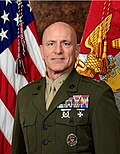Overview
The Secretary of Defense recognized the significance of the cyberspace domain to national security, and directed the establishment of USCYBERCOM as a sub-unified command under United States Strategic Command (USSTRATCOM). USCYBERCOM's primary objective is to integrate the cyberspace operations capabilities of the services and agencies in support of the National Strategy to Secure Cyberspace (NSSC). [8]
In response, the USMC established MARFORCYBER [9] in October 2009 (this was complemented by the standing up of the U.S. Fleet Cyber Command (FLTCYBER), U.S. Army Cyber Command (ARCYBER), and Air Forces Cyber (AFCYBER). MARFORCYBER's mission, in addition to its standard service component responsibilities, is to: plan, coordinate, integrate, synchronize, and direct the Corps' full spectrum of cyberspace operations. This includes Department of Defense (DoD) Information Network (DoDIN) [10] operations, Defensive Cyber Operations (DCO), and planning and, when required, executing Offensive Cyberspace Operations (OCO). These operations support MAGTF, Joint and combined cyberspace requirements that enable freedom of action across all warfighting domains and deny the same to adversarial forces.
Subordinate Units
Marine Corps Cyberspace Operations Group
MCCOG [11] directs global Network Operations (NETOPS) and computer network defense of the Marine Corps Enterprise Network (MCEN) [12] and to provide technical leadership in support of Marine and joint forces operating worldwide. The MCCOG is also responsible for intelligence gathering and analysis to develop future capabilities planning in accordance with DCO.
The MCCOG is the Computer Network Defense Service Provider (CNDSP) [13] and serves as the Corps' Global Network Operations and Security Center (GNOSC). The MCCOG provides 24/7 NETOPS C2 through its Operations Center. Under the OPCON (operational command) of MARFORCYBER, the MCCOG executes Information NETOPS and DCO in support of operational requirements in order to enhance freedom of action across all warfighting domains, while denying the efforts of adversaries to degrade or disrupt this advantage through cyberspace.
Key MCCOG tasks include:
- operating and defending the MCEN [12]
- collecting and sharing DoDIN Situational Awareness
- reporting and directing actions that proactively address threats and vulnerabilities
- responding to operational incidents
- providing technical leadership to ensure that our Corps and joint capabilities leverage new technologies to the advantage of the Marine warfighter
Marine Corps Cyber Warfare Group
MCCYWG [14] is an administrative headquarters that organizes, trains, equips, provides administrative support, manages readiness of assigned forces, and recommends certification and presentation of Cyber Mission Force (CMF) Teams to USCYBERCOM.
Key MCCYWG tasks include:
- Conduct personnel management to organize and assign individuals to work roles and place them in work centers to ensure operational readiness of CMF Teams
- Ensure all personnel are trained in accordance with USCYBERCOM Joint Cyberspace Training and Certification Standards and equipped to perform all duties and tasks outlined in the MARFORCYBER Mission Essential Task List (METL)
- Advise COMMARFORCYBER on force employment considerations
- Provide subject matter expertise for operational planning requirements
The Marine Corps Information Command (MARCOR INFOCOM) [15] was established on 1 October 2022 to provide the Marine Corps with an operational command that was capable of unifying information-related capabilities and functions to support Fleet Marine Forces (FMF) in competition and crisis. Creation of MARFOR INFOCOM was directed by the Commandant of the Marine Corps in the May 2022 Annual Update to Force Design 2030. [16] MARCOR INFOCOM is not “subordinate” to MARFOR CYBERCOM, but the Commander of MARFORCYBERCOM also serves as the Commanding General (CG) of MARCOR INFOCOM.
MARCOR INFOCOM comprises a headquarters staff and the following units:
This page is based on this
Wikipedia article Text is available under the
CC BY-SA 4.0 license; additional terms may apply.
Images, videos and audio are available under their respective licenses.







